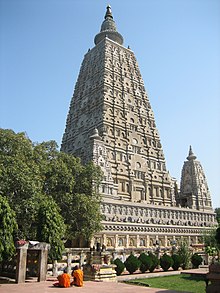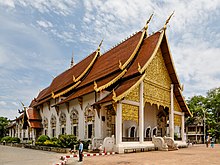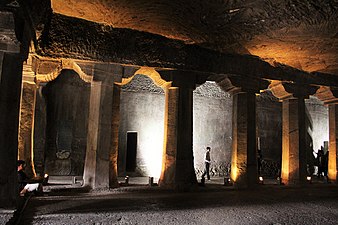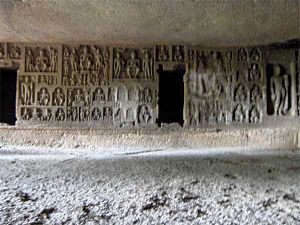Vihāra
Vihāra generally refers to a
Vihara or vihara hall has a more specific meaning in the architecture of India, especially ancient Indian rock-cut architecture. Here it means a central hall, with small cells connected to it, sometimes with beds carved from the stone. Some have a shrine cell set back at the centre of the back wall, containing a stupa in early examples, or a Buddha statue later. Typical large sites such as the Ajanta Caves, Aurangabad Caves, Karli Caves, and Kanheri Caves contain several viharas. Some included a chaitya or worship hall nearby.[8] The vihara originated as a shelter for monks when it rains.
Etymology and nomenclature
Vihāra is a Sanskrit word that appears in several Vedic texts with context-sensitive meanings. It generally means a form of "distribution, transposition, separation, arrangement", either of words or sacred fires or sacrificial ground. Alternatively, it refers to a form of wandering roaming, any place to rest or please oneself or enjoy one's pastime in, a meaning more common in late Vedic texts, the Epics and
Its meaning in the post-Vedic era is more specifically a form of rest house, temple or monastery in ascetic traditions of India, particularly for a group of monks.
It contrasts with
The eastern Indian state of Bihar derives its name from vihāra due to the abundance of Buddhist monasteries in that area. The word has also been borrowed in Malay as biara, denoting a monastery or other non-Muslim place of worship. It is called a wihan (วิหาร) in Thai, and vĭhéar (វិហារ [ʋihiə]) in Khmer. In Burmese, wihara (ဝိဟာရ [wḭhəɹa̰]), means "monastery", but the native Burmese word kyaung (ကျောင်း [tɕáʊɰ̃]) is preferred. Monks wandering from place to place preaching and seeking alms often stayed together in the sangha.[citation needed] In the Punjabi language, an open space inside a home is called a vehra.
In
Origins
Viharas as pleasure centers
During the 3rd-century BCE era of Ashoka, vihara yatras were travel stops aimed at enjoyments, pleasures and hobbies such as hunting. These contrasted with dharma yatras which related to religious pursuits and pilgrimage.[3] After Ashoka converted to Buddhism, states Lahiri, he started dharma yatras around mid 3rd century BCE instead of hedonistic royal vihara yatras.[3]
Viharas as monasteries
The early history of viharas is unclear. Monasteries in the form of caves are dated to centuries before the start of the common era, for
The earliest known gift of immovable property for monastic purposes ever recorded in an Indian inscription is credited to Emperor Ashoka, and it is a donation to the Ajivikas.

Buddhist viharas or monasteries may be described as a residence for monks, a centre for religious work and meditation and a centre of Buddhist learning. Reference to five kinds of dwellings (Pancha Lenani) namely, Vihara, Addayoga, Pasada, Hammiya and Guha is found in the Buddhist canonical texts as fit for monks. Of these only the Vihara (monastery) and Guha (Cave) have survived.
At some stage of Buddhism, like other Indian religious traditions, the wandering monks of the
Architecture
The only substantial remains of very early viharas are in the rock-cut complexes, mostly in north India, the
As the vihara acquired a central image, it came to take over the function of the chaitya worship hall, and eventually these ceased to be built. This was despite the rock-cut vihara shrine room usually offering no path for circumambulation or
In early medieval era, Viharas became important institutions and a part of Buddhist

Variants in rock-cut viharas
Usually the standard form as described above is followed, but there are some variants. Two vihara halls, Cave 5 at
Cave 11 at the Bedse Caves is a fairly small 1st-century vihara, with nine cells in the interior and originally four around the entrance, and no shrine room. It is distinguished by elaborate gavaksha and railing relief carving around the cell-doors, but especially by having a rounded roof and apsidal far end, like a chaitya hall.[23]
History

The earliest Buddhist rock-cut cave abodes and sacred places are found in the western Deccan dating back to the 3rd century BCE.[24] These earliest rock-cut caves include the Bhaja Caves, the Karla Caves, and some of the Ajanta Caves.
Vihara with central shrine containing devotional images of the Buddha, dated to about the 2nd century CE are found in the northwestern area of
The early stone viharas mimicked the timber construction that likely preceded them.[29]
Inscriptional evidence on stone and copper plates indicate that Buddhist viharas were often co-built with Hindu and Jain temples. The Gupta Empire era witnessed the building of numerous viharas, including those at the Ajanta Caves.[30] Some of these viharas and temples though evidenced in texts and inscriptions are no longer physically found, likely destroyed in later centuries by natural causes or due to war.[30]
Viharas as a source of major Buddhist traditions

As more people joined Buddhist monastic sangha, the senior monks adopted a code of discipline which came to be known in the
Three early influential monastic fraternities are traceable in Buddhist history.[32] The Mahavihara established by Mahinda was the oldest. Later, in 1st century BCE, King Vattagamani donated the Abhayagiri vihara to his favored monk, which led the Mahavihara fraternity to expel that monk.[32] In 3rd century CE, this repeated when King Mahasena donated the Jetavana vihara to an individual monk, which led to his expulsion. The Mahinda Mahavihara led to the orthodox Theravada tradition.[32] The Abhayagiri vihara monks, rejected and criticized by the orthodox Buddhist monks, were more receptive to heterodox ideas and they nurtured the Mahayana tradition. The Jetavana vihara monks vacillated between the two traditions, blending their ideas.[32]
Viharas of the Pāla era
This section needs additional citations for verification. (April 2015) |
A range of monasteries grew up during the Pāla period in ancient Magadha (modern Bihar) and Bengal. According to Tibetan sources, five great
Other notable monasteries of the Pala Empire were Traikuta, Devikota (identified with ancient Kotivarsa, 'modern Bangarh'), and Pandit Vihara. Excavations jointly conducted by the Archaeological Survey of India and University of Burdwan in 1971–1972 to 1974–1975 yielded a Buddhist monastic complex at Monorampur, near Bharatpur via Panagarh Bazar in the Bardhaman district of West Bengal. The date of the monastery may be ascribed to the early medieval period. Recent excavations at Jagjivanpur (Malda district, West Bengal) revealed another Buddhist monastery (Nandadirghika-Udranga Mahavihara)[36] of the ninth century.
Nothing of the superstructure has survived. A number of monastic cells facing a rectangular courtyard have been found. A notable feature is the presence of circular corner cells. It is believed that the general layout of the monastic complex at Jagjivanpur is by and large similar to that of Nalanda. Beside these, scattered references to some monasteries are found in epigraphic and other sources. Among them Pullahari (in western Magadha), Halud Vihara (45 km south of Paharpur), Parikramana vihara and Yashovarmapura vihara (in Bihar) deserve mention. Other important structural complexes have been discovered at Mainamati (Comilla district, Bangladesh). Remains of quite a few viharas have been unearthed here and the most elaborate is the Shalban Vihara. The complex consists of a fairly large vihara of the usual plan of four ranges of monastic cells round a central court, with a temple in cruciform plan situated in the centre. According to a legend on a seal (discovered at the site) the founder of the monastery was Bhavadeva, a ruler of the Deva dynasty.[citation needed]
Southeast Asia

As Buddhism spread in Southeast Asia, monasteries were built by local kings. The term vihara is still sometimes used to refer to the monasteries/temples, also known as
Image gallery
-
Cave 4, Ajanta Caves
-
Entrance to a vihara hall at Kanheri Caves
-
Wall carvings at Kanheri Caves
-
Simple slab abode beds in vihara at Kanheri Caves
-
Doorways of a Vihara, Bedse Caves
See also
- List of Buddhist universities across the world
- Ashram
- Bahal, Nepal
- Brahma-vihara
- Gal Vihara
- Kyaung
- Mahavihara
- Mahiyangana Raja Maha Vihara
- Nava Vihara
- Tissamaharama Raja Maha Vihara
- Vihara Buddhagaya Watugong
- Wat – Buddhist temple in Cambodia, Laos or Thailand.
Notes
- ISBN 978-1-884964-04-6.
- ^ a b c d e Vihara, Monier Monier Williams, Sanskrit-English Dictionary Etymologically Arranged, Oxford University Press, p. 1003
- ^ ISBN 978-0-674-91525-1.
- ^ ISBN 978-81-208-0223-0.
- ^ ISBN 1-134-50165-X.
- ^ Gomaṭeśvara sahasrābdī mahotsava darśana, Niraj Jain, Śravaṇabelagola Digambara Jaina Muzaraī Insṭīṭyuśaṃsa Mainejiṅga Kameṭī, 1984, p. 265
- ^ Tulasī prajñā, Jaina Viśva Bhāratī, 1984, p. 29
- ISBN 0140081445
- ^ Hermann Oldenberg; Friedrich Max Müller (1892). The Grihya-sûtras, Rules of Vedic Domestic Ceremonies. Clarendon Press: Oxford. pp. 54–56, 330–331.
- ^ ISBN 978-81-208-1532-2.
- ^ a b c Vihara, Pali English Dictionary, T. W. Rhys Davids, William Stede, editors; Pali Text Society; p. 642
- ISBN 978-0-8108-7984-3.
- ISBN 978-81-208-1968-9.
- ^ . Journal Asiatique. 302 (1): 111–138.
- ^ ISBN 978-0-521-37695-2.
- ISBN 978-1-118-97228-1.
- ISBN 978-81-208-0805-8.
- ISBN 978-0-521-37695-2.
- ^ ISBN 978-90-04-20140-8.
- ^ Harle, 48, 54–56, 119–120; Michell, 67
- ^ Harle, 132; Michell, 67
- ^ Michell, 359, 374
- ^ Michell, 351–352
- ISBN 0-7946-0011-5.
- ^ ISBN 9004135952.
- ^ a b Susan L. Huntington (1990), Early Buddhist Art and the Theory of Aniconism, Art Journal, Volume 49, 1990. Issue 4: New Approaches to South Asian Art, pp. 401–408
- ISBN 978-1-351-39432-1.
- ISBN 978-90-04-18525-8.
- ^ "Entrance Cave 9, Ajanta". art-and-archaeology.com. Retrieved 2007-03-17.
- ^ ISBN 978-1-4529-1225-7.
- ^ ISBN 978-0-19-532684-0.
- ^ ISBN 978-0-521-85942-4.
- ISBN 90-04-06856-2.
- ISBN 0-86171-329-X.
- OCLC 372316.
- ^ "Jagjivanpur, A newly discovered Buddhist site in west Bengal". Information & Cultural Affairs Department, Government of West Bengal. Archived from the original on 9 August 2009.
- ISBN 9789747534405.
- ^ ISBN 978-1-4384-2165-0.
- ISBN 978-0-521-85942-4.
References
- Chakrabarti, Dilip K. (October 1995). "Buddhist Sites across South Asia as Influenced by Political and Economic Forces". World Archaeology. 27 (2): 185–202. JSTOR 125081.
- Harle, J.C., The Art and Architecture of the Indian Subcontinent, 2nd edn. 1994, Yale University Press Pelican History of Art, ISBN 0300062176
- Khettry, Sarita (2006). Buddhism in North-Western India: Up to C. A.D. 650. Kolkata: R.N. Bhattacharya. ISBN 978-81-87661-57-3.
- Michell, George, The Penguin Guide to the Monuments of India, Volume 1: Buddhist, Jain, Hindu, 1989, Penguin Books, ISBN 0140081445
- Mitra, D. (1971). Buddhist Monuments. Calcutta: Sahitya Samsad. ISBN 0-89684-490-0.
- Rajan, K.V. Soundara (1998). Rock-cut Temple Styles: Early Pandyan Art and The Ellora Shrines. Mumbai: Somaiya Publications. ISBN 81-7039-218-7.
- Tadgell, C. (1990). The History of Architecture in India: From the Dawn of Civilization to the End of the Raj. London: Phaidon. ISBN 1-85454-350-4.
External links
- Lay Buddhist Practice: The Rains Residence – A short article on the meaning of Vassa, and its observation by lay Buddhists.
- Mapping Buddhist Monasteries A project aiming to catalogue, crosscheck, verify and interrelate, tag and georeference, chronoreference and map online (using KML markup & Google Maps technology).







